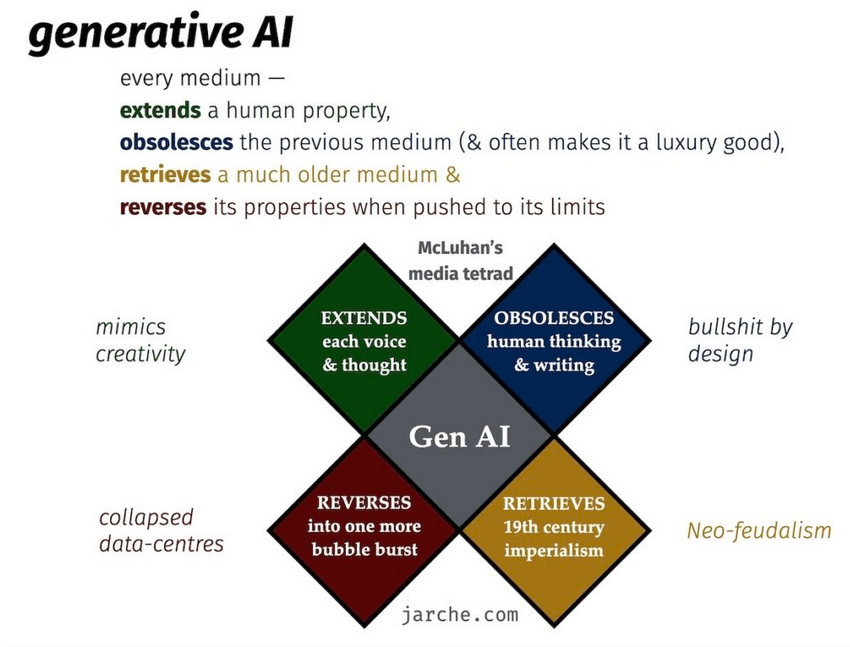Yesterday, Ethan Mollick had an interesting post in his Substack about Latent Expertise. He noted “…There are areas where AI is better than an expert human at particular tasks, and areas where it is completely useless. Instead of blanket statements, we should focus on specifics: we know that LLMs, without further development, are already useful as a co-intelligence that greatly improves human performance (in innovation, productivity, coding, and more), but we also have yet to figure out every strength and weakness.”
He went on to state that “…Unlocking the expertise latent in AI is, for now, a job for experts. There are multiple reasons for this. The first is that experts can easily judge whether work in their field is good or bad, and in what ways” (my italics).
Experts … is that not another term for teachers and faculty?
Generative AI has already been widely adopted by many. including our students. It seems incumbent on us who are in the teaching profession to understand and actively use AI to promote learning. As Harold Jarche pointed out in April, the problem with AI is that it can generate a lot of bull!
To limit the amount of bull, teachers and professors should model effective use of AI, and that suggests becoming effective at prompting AI to give deeper responses rather than surface level ones.
Dan Fitzpatrick in a Forbes article entitled “5 AI Prompts For Educators Using ChatGPT And Google Gemini” discussed how educators are using AI tools to enhance their teaching. The article emphasized the importance of using AI tools like ChatGPT and Google Gemini (and I would add Claude) conversationally, engaging in back-and-forth dialogue to uncover more details and understanding. He presented five powerful prompts shared by innovative teachers. Check them out, they really show the level of detail one should put into prompts. Just one example:
“Your role is to emulate an Oxbridge/Ivy League professor specializing in [Subject]. Your demeanor is friendly and patient, yet traditionally academic, fostering a respectful and serious interview environment. Begin by discussing personal statements and then delve into deeper topics, in line with current studies. Your questioning style should encourage critical thinking and problem-solving, while maintaining a supportive atmosphere. In case of unclear queries, seek clarification first, then make educated guesses or suggest topic changes if necessary. After providing an answer to a technical question, you should naturally progress to a closely related issue within the same topic.”
And one does not have to unimaginative in prompting. I like Caplan’s ideas in his Fast Company article entitled “Here are some surprising (and fun) ways to prompt AI“, where he looked for the strange, weird, surprising, bold and radical ideas that prompts might surface. The article emphasized the value of unexpected perspectives in stretching one’s thinking and breaking out of creative ruts, and suggested ways to prompt AI tools to generate more creative, unconventional responses, as AI outputs can often be predictable.
- Propose 5 questions a reader would be surprised to find answered on [your topic X]
- What are 3 quirky, unusual analogies to explain [your phenomenon of interest].
- Who are 7 surprising, odd historical figures to cite as examples of [X]. For each individual include a detailed explanation.
- What rarely discussed, counterintuitive insights on the subject of [X] might startle readers accustomed to bland observations?
- Give me 5 lively, colorful, unusual words to use in a description of [X]?
- Provide 3 extreme, surprising examples of [X] or silly, ridiculous instances.
- Share 5 counterintuitive ways to address situation [X]
- Imagine I shocked people with a one sentence answer to the following question: [X]. Give me 10 versions of that one-sentence reply.
- I have [X challenge] in [Y situation]. Assume I want to surprise people with a wildly creative solution. Describe three solutions that would stun people while addressing the root of the issue.
- For a syllabus I’m creating on [X], imagine seven radically different people teaching the same course. Provide three bullet points representing each teacher, explaining the surprising and distinct learning outcomes each would aim for in their version of the class.
And I certainly had fun using DALL-E to create the images in this post!
By embracing AI tools and mastering the art of effective prompting, we can unlock new realms of creativity, critical thinking, and personalized learning for our students. The prompts and strategies shared in these two articles are just the beginning. We need to add “AI Expert” to our job descriptions! We as teachers and faculty need to experiment (or dare I say “play”), iterate, and share our own AI discoveries with colleagues.
I strongly believe that our expertise as teachers and faculty is not diminished by AI, but rather enhanced.
We have the power to guide our students in using these tools responsibly and effectively, preparing them for a future where human-AI collaboration will be the norm. Let’s lead by example and show our students how to harness the full potential of AI in education.
{Graphics by DALL-E and Jarche}


